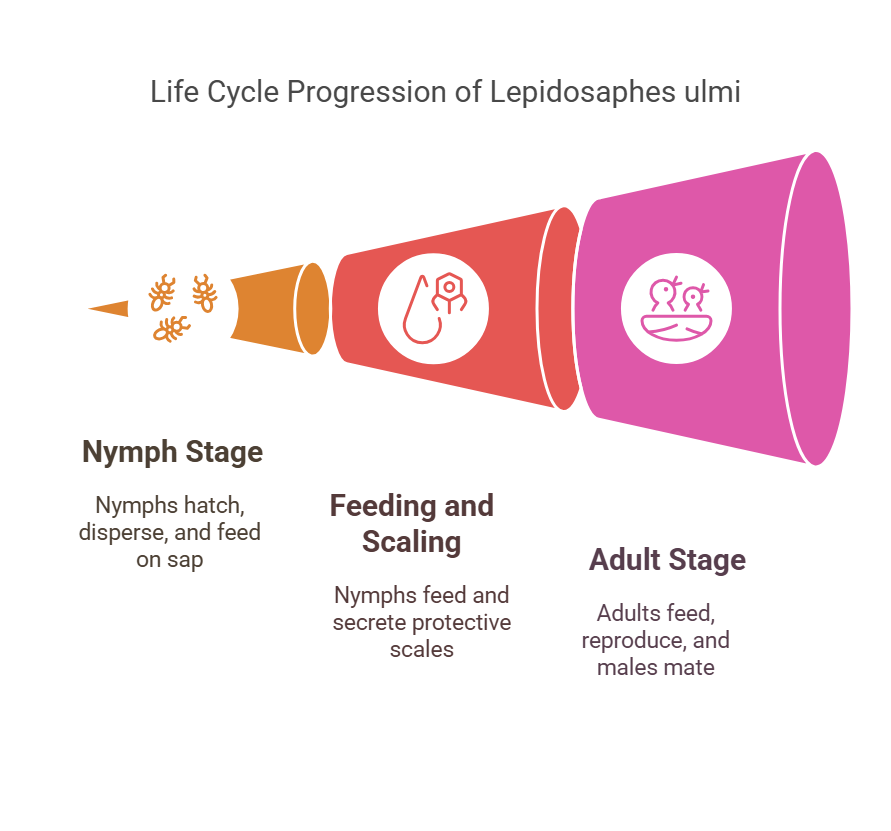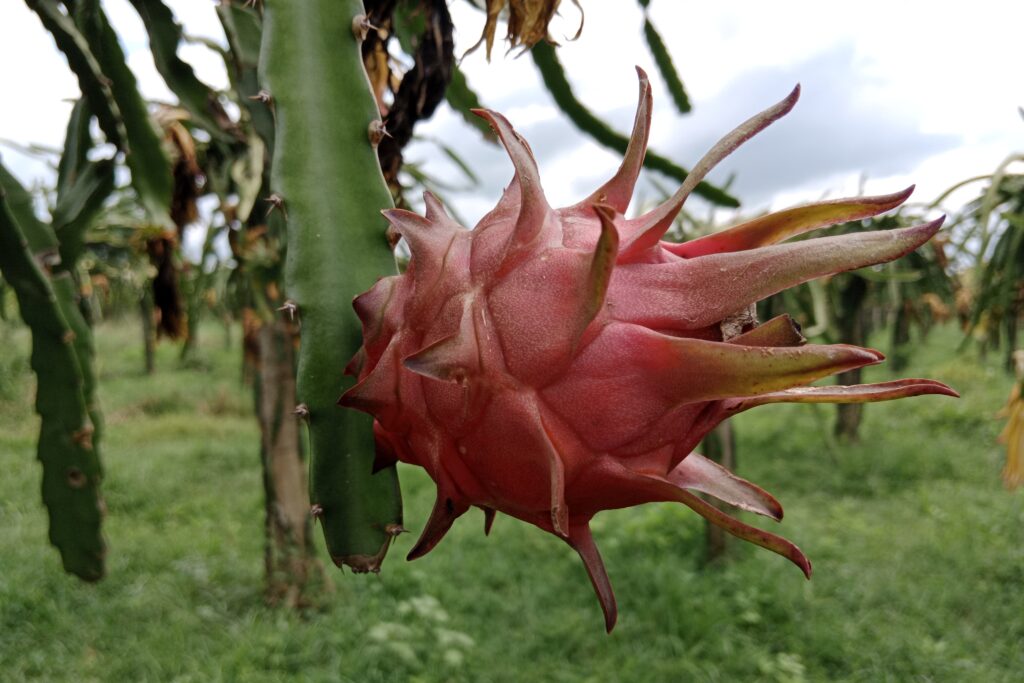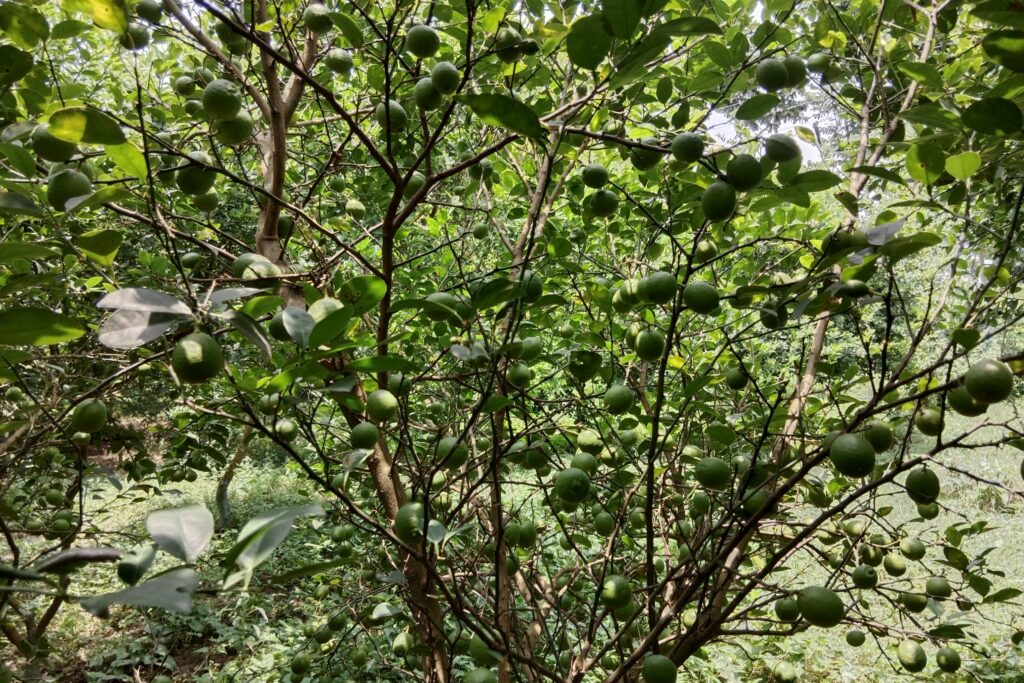Mussel Scale (Lepidosaphes ulmi)
The mussel scale (Lepidosaphes ulmi) is a highly destructive armored scale insect belonging to the family Diaspididae. Recognized for its polyphagous feeding behavior, this pest infests a wide range of plant species, including fruit trees, ornamental plants, and shrubs, posing a severe threat to both agricultural and horticultural industries. Its hard, protective covering makes it difficult to control through conventional means, compounding the challenges it presents.
The pest is particularly notorious in apple orchards, where infestations can result in substantial economic losses. Symptoms of damage include stunted growth, discoloration of leaves, reduced photosynthesis, premature fruit drop, and significant reductions in fruit quality and yield. In young apple trees, heavy infestations may cause dieback and even complete tree decline if left unchecked. The adaptability and resilience of L. ulmi make it a formidable pest requiring integrated pest management strategies to mitigate its impact effectively.
Morphological Characteristics of Mussel Scale (Lepidosaphes ulmi)
The mussel scale is a distinct and easily recognizable armored scale insect, identifiable by several key morphological traits. These features play a crucial role in its identification and help distinguish it from other scale insects.
Size & Shape
Adult mussel scales typically measure between 2 to 4 millimeters in length. Their bodies are elongated and curved, resembling the shape of a mussel shell, which is the basis for their common name. This unique shape not only aids in identification but also allows the scales to adhere snugly to plant surfaces, such as tree bark and twigs.
Coloration
The coloration of the mussel scale varies, typically ranging from grey to yellowish-brown. This coloration provides an excellent camouflage, enabling the insect to blend seamlessly with the bark of woody plants. This natural disguise can make infestations difficult to detect, particularly in the early stages.
Protective Covering
A defining characteristic of the mussel scale is its hard, protective covering. Unlike soft scales, which are more vulnerable, mussel scales produce a shield composed of waxy secretions and layers of old molted skins. This protective armor serves as a barrier against environmental hazards and predators, while also rendering them highly resistant to many chemical pesticides. This durability significantly complicates control efforts, often necessitating the implementation of integrated pest management (IPM) strategies to combat infestations effectively.
These morphological adaptations not only contribute to the pest’s survival and proliferation but also underscore the importance of accurate identification and tailored management practices in mitigating its impact on agricultural and horticultural systems.
Life Cycle and Reproduction
Understanding the life cycle of Lepidosaphes ulmi is crucial for effective management:

Egg Stage
Females lay eggs under their protective scale covering, shielding them from environmental hazards and predators.
Nymph (Crawler) Stage
Tiny, mobile crawler nymphs hatch and disperse to find suitable feeding sites. Once settled, they insert their piercing-sucking mouthparts into plant tissue and begin feeding on sap. Shortly after, they secrete a hard protective scale, losing their mobility.
Adult Stage
Females remain stationary, continuing to feed and reproduce. Males develop wings, emerge to mate, and die shortly afterward, as they do not feed.
Reproductive Rate
Multiple generations can occur annually, especially in warmer climates, leading to rapid population growth and severe infestations.
Also Read About: Brown Soft Scale
Host Range and Agricultural Impact of Mussel Scale (Lepidosaphes ulmi)
The mussel scale (Lepidosaphes ulmi) is a highly polyphagous pest, capable of infesting a broad spectrum of woody plants across different agricultural, horticultural, and forested landscapes. Its extensive host range and destructive feeding habits make it a significant concern for farmers, orchardists, and landscape managers alike.
Primary Host Plants
The mussel scale demonstrates a strong preference for fruit-bearing trees, with apple trees (Malus domestica) being particularly vulnerable to infestations. Young apple trees are especially at risk due to their smaller size and limited reserves, which make them less able to tolerate the sap depletion caused by the pest. Other key hosts include pear (Pyrus spp.), plum (Prunus domestica), cherry (Prunus avium), and a variety of stone fruit trees.
In addition to fruit crops, the mussel scale frequently infests ornamental and forest trees. Common hosts in this category include lilac (Syringa spp.), willow (Salix spp.), and poplar (Populus spp.). These infestations can negatively affect both the aesthetic and ecological value of the affected trees, reducing their vigor and making them more susceptible to other stresses.
Damage Symptoms
Infestations by the mussel scale result in several detrimental symptoms across host plants:
- Sap Depletion: The mussel scale uses its piercing-sucking mouthparts to extract plant sap, depriving the plant of essential nutrients and energy.
- Stunted Growth: Continuous feeding weakens the plant, leading to reduced growth rates and diminished vitality.
- Leaf Yellowing and Drop: Affected plants often exhibit chlorotic (yellowing) leaves, followed by premature leaf drop, which further compromises photosynthesis and energy reserves.
- Bark Damage: Heavy infestations can cause cracking and splitting of the bark, exposing the plant to environmental stress and secondary infections by pathogens such as fungi and bacteria.
- Dieback: Persistent infestations may result in the dieback of branches and twigs, particularly in young or stressed plants.
- Tree Mortality: In severe cases, particularly in young apple orchards, the combined effects of sap depletion, structural damage, and secondary infections can lead to tree death.
Agricultural and Economic Impact
The mussel scale poses a significant economic threat to commercial orchards and nurseries. Yield losses are common due to reduced fruit quality and quantity, while the aesthetic damage to ornamental trees affects their market value. Infestations also increase production costs, as growers must invest in integrated pest management (IPM) strategies to control the pest effectively.
In the long term, unmanaged infestations can lead to declining orchard productivity, reduced tree lifespan, and increased vulnerability to other pests and diseases. This underscores the importance of early detection, continuous monitoring, and the implementation of robust pest control measures to mitigate the agricultural and ecological impacts of Lepidosaphes ulmi.
Management and Control Strategies
Controlling Lepidosaphes ulmi is challenging due to its protective scale covering. An integrated pest management (IPM) approach is essential, combining biological, cultural, and chemical methods:
Biological Control
- Natural Enemies
Predatory insects like ladybird beetles (Chilocorus spp.) and lacewing larvae (Chrysopidae) feed on crawlers and young scales. Parasitic wasps (Aphytis spp. and Encarsia citrina) also attack scale nymphs, helping to regulate populations.
- Encouraging Beneficial Insects
Avoiding broad-spectrum insecticides preserves natural enemies and enhances biological control.
Cultural Control
Monitoring & Early Detection: Regular inspection of tree bark and leaves can help detect infestations early.
Pruning Infested Branches: Heavily infested branches should be pruned and destroyed to reduce scale populations.
Horticultural Practices: Improving tree vigor through proper fertilization, irrigation, and pruning helps trees withstand damage.
Chemical Control
Horticultural Oils: Dormant oil sprays applied in winter suffocate overwintering scales and reduce populations before the growing season.
Insecticides: Systemic insecticides like neonicotinoids (imidacloprid) are effective when applied during crawler emergence. Contact insecticides must be timed precisely to target the crawler stage, as adult scales are highly resistant.
Conclusion
The mussel scale (Lepidosaphes ulmi) is a highly damaging armored scale insect, posing a significant threat to young apple trees and other woody plants. Its polyphagous nature and protective scale covering make infestations particularly challenging to manage. Implementing integrated pest management strategies—combining biological control, cultural practices, and targeted chemical treatments—is crucial to minimizing damage and safeguarding tree health. By adopting a proactive and holistic approach, growers can effectively mitigate the impact of this persistent pest.


